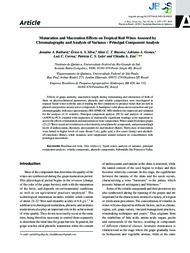Maturation and maceration effects on tropical red wines assessed by chromatography and analysis of variance: principal component analysis.
Maturation and maceration effects on tropical red wines assessed by chromatography and analysis of variance: principal component analysis.
Author(s): BARBARA, J. A.; SILVA, E. A. S.; BIASOTO, A. C. T.; GOMES, A. A.; CORREA, L. C.; LEAO, P. C. de S.; ZINI, C. A.
Summary: Effects of grape maturity, maceration length during winemaking and interaction of both of them on physicochemical parameters, phenolic and volatile composition were investigated in tropical Syrah wines with the aim of finding the best conditions to produce wines that are rich in phenols and positive aroma active compounds. A headspace solid phase micro extraction and gas chromatography with mass spectrometry (HS-SPME-GC-MS) method was improved and validated or the analysis of 41 volatiles. Principal component analysis (PCA) and analysis of variance (ANOVA)-PCA coupled with inspection of statistically significant loadings were important to access the effects of maturation and maceration on wine composition. Wines made from riper grapes (21-23 °Brix) stood out in relation to color intensity, total phenolic compounds, and presented high levels of anthocyanins, flavonols, procyanidin A2, and linalool (floral). Thirty days of maceration were linked to higher levels of some flavan-3-ols, gallic acid, a few esters (fruity) and alcohols, (E)-nerolidol (floral), while nonanoic acid (unpleasant aroma) reduced its concentration with prolonged maceration.
Publication year: 2019
Types of publication: Journal article
Unit: Embrapa Semi-arid Region
Observation
Some of Embrapa's publications are published as ePub files. To read them, use or download one of the following free software options to your computer or mobile device. Android: Google Play Books; IOS: iBooks; Windows and Linux: Calibre.
Access other publications
Access the Agricultural Research Database (BDPA) to consult Embrapa's full library collection and records.
Visit Embrapa Bookstore to purchase books and other publications sold by Embrapa.

